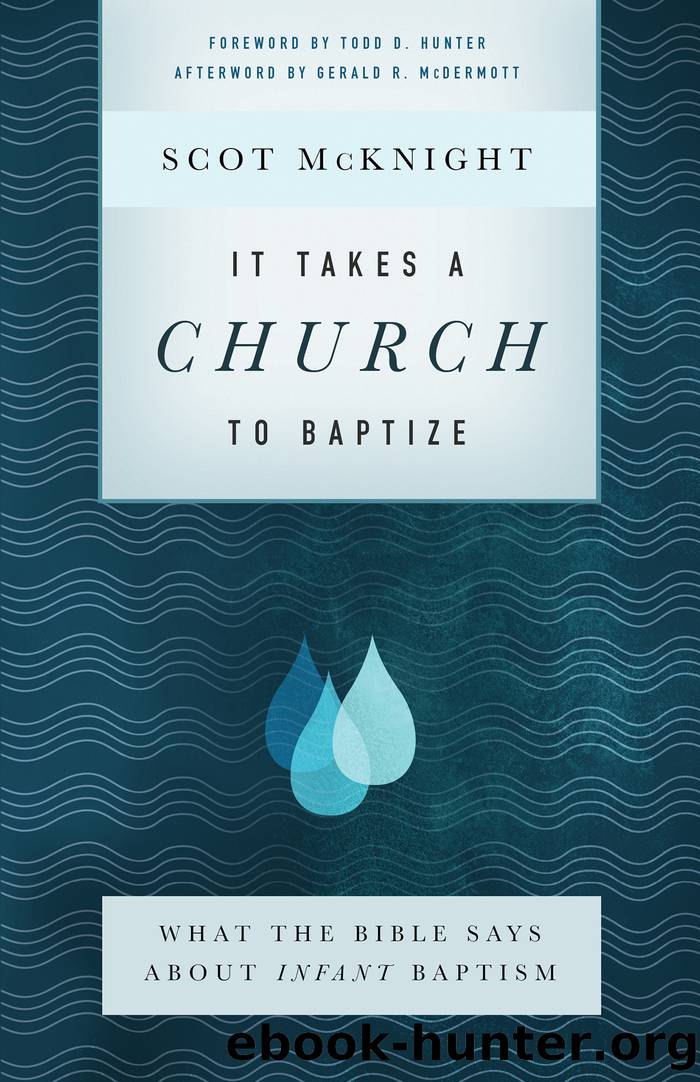It Takes a Church to Baptize by Scot McKnight

Author:Scot McKnight
Language: eng
Format: epub
Tags: Baptism;Infant baptism;REL055000;REL108000;REL003000
ISBN: 9781493414635
Publisher: Baker Publishing Group
Published: 2018-06-07T00:00:00+00:00
We turn back to earlier discussions for an important reminder: the covenant formed with Abraham was located in his family because the family was central to all âreligiousâ life in ancient Israel. It was not just Abraham who was circumcised. Abrahamâs son was as well. In ancient Israel, as in all religions of the Greek and Roman world, one did not choose oneâs religion. Oneâs religion was inherited. Religion was something passed to oneâs children by way of culture, instruction, and family traditions. Surrounding that family was a community, a tribal region in the land of Israel, and a nation. Circumcision, then, was never a solo act by a solo father on a solo son. It was preeminently an act of a father on a son in the context of the fatherâs own circumcision and in the context of a family, a community, and a nation. That son became not only part of the family but a potential functioning member of an entire nation. The swift cut of the knife authorized that child to be part of a community.
So, typical for the ancient world, and central to how God chose to work with Israel, the covenant God made with father Abraham became effective for his whole household, as it did for the rest of Israelâs history. Children who grew up in Judaism didnât choose to join Judaism; they were already incorporated into Judaism from the day of their birth. Judaism then was a household covenant-based faith with the God of Israel, YHWH. The New Testament texts make it more than clear that entire households were baptized.
With that term we begin to enter the first reason for infant baptism. That very term âhouseholdâ was an inclusive term, and in the New Testament we hear for the first time of the baptism of entire households.1 The first and most important question about household baptism is this: What exactly was a household? Was it the house itself? The father only? The father and the mother? The father and anyone in the household who was old enough to believe and who did believe and repent? Everyone in and attached to the house, including slaves and servants and relatives and dependents? Ask this set of questions to anyone who knows the ancient world and you get this answer or something like it: a household included a father, his wife, his children, his or her siblings, his or her parents and grandparents and relatives, as well as domestic slaves and even the homeless who have been given shelter. Not all persons in the household, of course, had the same status or rights, but this point cannot be overemphasized: a household included everyone in the household!2 (I will discuss this below.)
Therefore, to baptize a household meant to baptize more than the new-covenant member, which in most cases was the father or mother. To baptize a household was to baptize everyone in the household. Everyone means everyone, not just some. We should also emphasize that the early Christian
Download
This site does not store any files on its server. We only index and link to content provided by other sites. Please contact the content providers to delete copyright contents if any and email us, we'll remove relevant links or contents immediately.
| Anglican | Baptist |
| Book of Common Prayer | Calvinist |
| Episcopalian | Inspirational |
| Lutheran | Methodist |
| Pentecostal & Charismatic | Presbyterian |
| Quaker | Seventh-Day Adventist |
| Shaker | Theology |
Angels by Billy Graham(1906)
How To Be Born Again by Billy Graham(1759)
Peace with God by Billy Graham(1663)
Unbroken Curses by Rebecca Brown & Daniel Yoder(1549)
God's Prophetic Symbolism in Everyday Life by Adam Thompson & Adrian Beale(1467)
The School of Biblical Evangelism by Ray Comfort(1415)
Call by Rick Joyner(1399)
Martin Luther: The Man Who Rediscovered God and Changed the World by Eric Metaxas(1377)
Power over the Enemy by John Osteen & Joel Osteen(1327)
Jonathan Edwards: A Life by Marsden George M(1217)
Fresh Wind, Fresh Fire by Jim Cymbala(1216)
Prayers That Bring Healing and Activate Blessings: Experience the Protection, Power, and Favor of God by John Eckhardt(1205)
Liturgy of the Ordinary by Tish Harrison Warren(1194)
The Supernatural Power of a Transformed Mind Expanded Edition: Access to a Life of Miracles by Bill Johnson(1188)
Unmasking the Devil: Strategies to Defeat Eternity's Greatest Enemy by John Ramirez(1178)
An Altar in the World by Barbara Brown Taylor(1171)
Reformation Theology by Littlejohn Bradford(1164)
Martin Luther by Mansch Larry D.; Peters Curtis H.;(1122)
Seeing the Voice of God: What God Is Telling You through Dreams and Visions by Smith Laura Harris(1119)
